 |
||
|
||
| ||
Part 1. ASUS, Foxconn, GlacialTech, Thermaltake, and TitanWe should complain about stagnation in the segment of budget coolers for AMD processors that has led to a monotonous product range. The roots of it are permanently growing manufacturing costs, high competition, price erosion, and serious pressure from boxed CPUs, which are very popular among end users and are supported by conservative PC builders. All these factors also narrow the segment of budget coolers. Nevertheless, budget cooling systems for AMD processors are in a better position than products for Intel CPUs. Historically being designed for a rather bland thermal envelope of Athlon 64 processors, such coolers have always been notable for simple design and consequently wider profit margin keeping their production on a rational level even these days. As a result, the market of budget coolers for AMD processors is still saturated. Vendors often present new products in this very segment even though the budget cooling market for LGA775 platform is much bigger. Thus we can state that the market of budget coolers for AMD processors is still alive. And it won't hurt to review some new products, namely 16 coolers from ASUS, Foxconn, GlacialTech, Thermaltake, and Titan. Following our good tradition, this shootout will be supplemented with technical ratings compiled from test results of many autumn and winter products launched this year. ASUS K8A1-8LB3 and K8A4-8LB3We'll start with two ASUS products - K8A1-8LB3 and K8A4-8LB3 coolers. 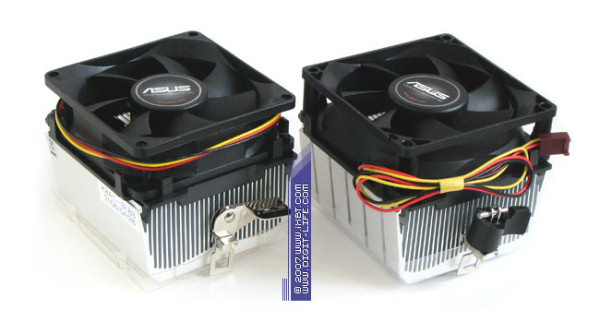 ASUS K8A1-8LB3 and K8A4-8LB3 The K8A1-8LB3 is a budget product, but it features an optimistic design - it's based on a neat aluminum heat sink (80x77x40 mm, 77x60 mm at the base) with decent finning (trapezoid fins, 0.8 mm at the base, 0.3 mm at the tip, at 1.5 mm steps, the total heat exchange surface is 1600 cm2). This heat sink and a 80x80x25 mm fan (plain bearing, nominal rotational speed - 3000 rpm) form a good thermal tandem.  Indeed, this product performs well. The K8A1-8LB3 demonstrates good results, consolidating interesting thermal parameter and acceptable noise characteristics. However, this cooler still has some design flaws: its toolless mounting clip is too hard and inconvenient (you have to use force to fix the heat sink in a socket), the on-board fan is not of the highest quality either.  As a result, the image of K8A1-8LB3 suffers, so it fails to raise to the top of our usability rating. Another budget cooler (K8A4-8LB3) is actually an overhauled K8A1-8LB3 - this cooler comes with the same aluminum heat sink (80x77x40 mm) with some minor facelift changes (crosscuts in its fins, which should improve ventilation of near-socket components) and a faster fan (3400 rpm). 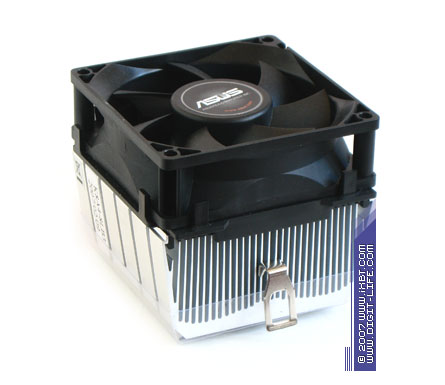 The retention module is also improved, it significantly facilitates the installation process, making it truly user-friendly. Another improvement is a new thermal interface - highly efficient thermal grease with advanced thermophysical parameters (based on aluminum oxide). 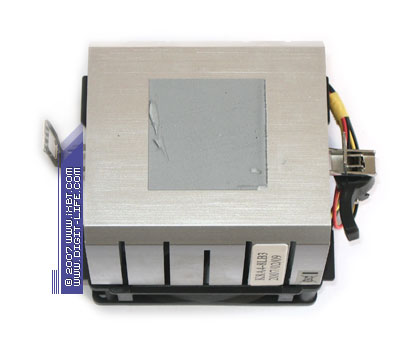 Unfortunately, performance of this product changes in the opposite direction. It actually overweighs all its technical improvements. The problem is in the new on-board fan with a poor aerodynamic configuration. It improves thermal efficiency of the K8A4-8LB3, but it significantly deteriorates noise characteristics of the cooler (its noise level has grown by 8 dBA, although its speed is increased insignificantly versus K8A1-8LB3). As a results, overall functionality of the K8A4-8LB3 is spoilt - it's outperformed not only by the old K8A1-8LB3, but also by many competing products. It sticks with the outsiders in our usability and economic ratings. Foxconn NBT-CMAM22B-C and NBT-CMAM23B-CLet's proceed to budget coolers from Foxconn - NBT-CMAM22B-C and NBT-CMAM23B-C. 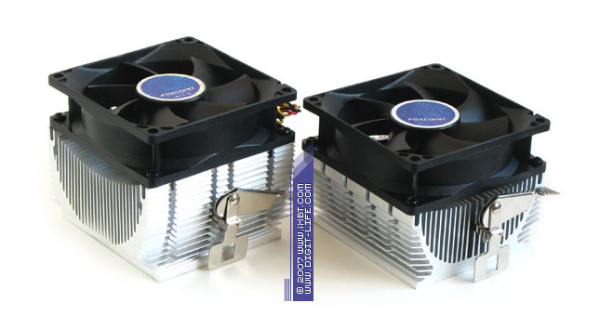 Foxconn NBT-CMAM22B-C and NBT-CMAM23B-C The NBT-CMAM22B-C looks unusual. Instead of the typical rectangular finned heat sink this product uses a complex configuration - a U-shaped base with impressive fins (80x80x47 mm, 78x68 mm at the base) not only inside the working medium, but also at the sides. 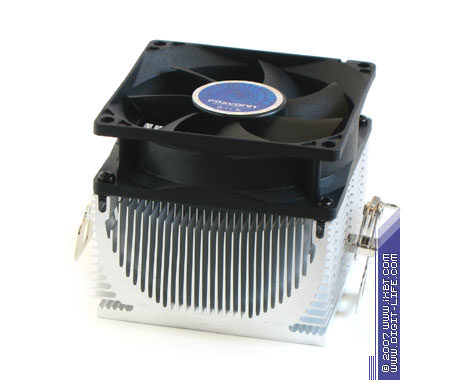 It's not an indubitable solution (it's a decoration rather than a real innovation), but the design of this heat sink offers very good parameters - trapezoid fins, 1 mm at the base, 0.3 mm at the tip, placed at 1.5 mm steps, total heat exchange surface - 1400 cm2. A copper disc (36x4 mm) pressed into the base acts as an extra thermal ameliorant. 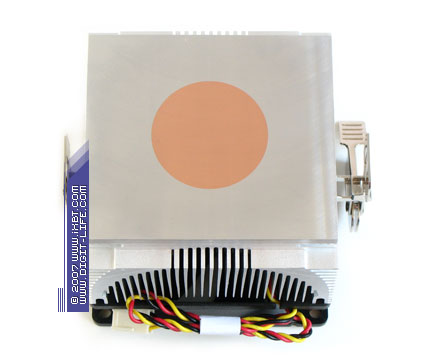 With its individual heat sink and a fast 80x80x25 mm fan (combined bearing, 2500 rpm), the NBT-CMAM22B-C achieves a good balance between noise characteristics and thermal efficiency, it significantly outperforms older Foxconn products and competes well with other budget products. But the overall functionality of the NBT-CMAM22B-C is not very good, despite its good retention module and acceptable fan - it can hardly compete with more advanced budget coolers, you can see it in its total rating. The Foxconn NBT-CMAM23B-C is a cut-down modification of the NBT-CMAM22B-C - the cooler is equipped with a slowed-down fan (combined bearing, 2000 rpm) and is based on a similar but smaller aluminum heat sink (77x77x38 mm, 77x68 mm at the base) with much weaker finning (rectangular fins, 0.9 mm thick, placed at 2 mm steps, total heat exchange surface - 900 cm2). 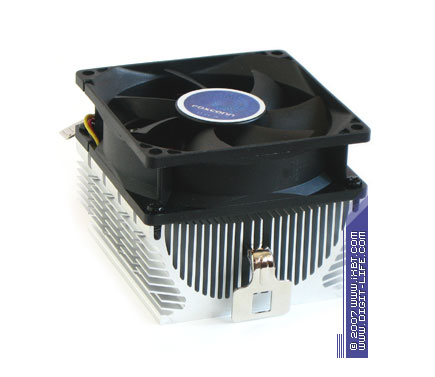 So you cannot expect miracles from the NBT-CMAM23B-C, of course. It demonstrates weak results and is outperformed by the NBT-CMAM22B-C both in thermal efficiency and in efficiency/noise ratio. It's only insignificantly better than the older products.  Even though this product goes only slightly behind the advanced NBT-CMAM22B-C in its overall functionality (improved noise ergonomics), it fails to get a decent usability rating. However, the NBT-CMAM23B-C fares better in the economic ratings - it comes closer to the leaders owing to its very attractive price tag. GlacialTech Igloo 7222 Light (E) and Igloo 7222 (E)And now we'll examine budget coolers of the updated Igloo 7222 family from GlacialTech - Igloo 7222 Light (E) and Igloo 7222 (E). These coolers are based on the same aluminum heat sink (77x68x36 mm), they are equipped with a 70x70x15 mm fan (plain bearing), and they differ in fan speed (2600 rpm and 3200 rpm). 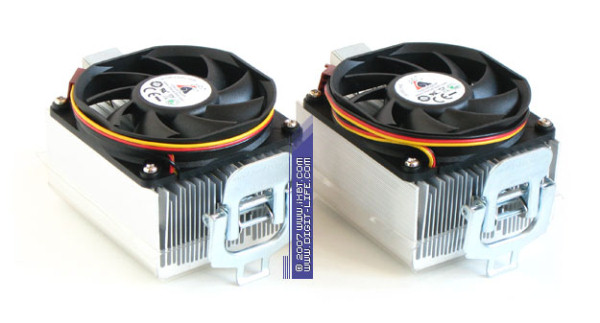 GlacialTech Igloo 7222 Light (E) and Igloo 7222 (E) The new Igloo 7222 products are practically complete technical replicas of the Igloo 7220 family. They develop their laconic compact ideology aimed to reach an optimal balance between design and thermal parameters - the heat sink has become even stumpier, the fan has also shrunk to 70x70x15 mm. All these components help the products lose weight to the lowest level of 260 g (30 g less than the Igloo 7220) and become very compact indeed.  GlacialTech Igloo 7220 Pro (E) and Igloo 7222 (E) The new family is also just as good in thermal terms: a heat sink of the Igloo 7222 gets traditional catalysts of thermal efficiency - trapezoid fins of alternating height (a symbiosis of tools to provide an increased heat exchange coefficient and hydraulic optimization of finning), spiced up with advanced parameters (fins - 0.5 mm thick at the base and 0.2 mm at the tip, placed at 1.5 mm steps, total heat exchange surface of about 1550 cm2). 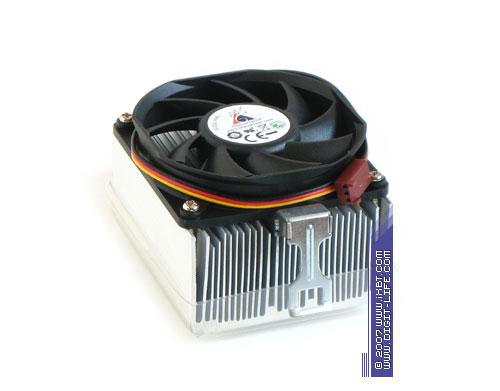 These coolers also look well as far as their usability is concerned - the proprietary retention module inherited from the Igloo 7220 remains truly friendly to users so that the heat sink can be quickly mounted on a socket. Besides, we should pay attention to the preinstalled thermal interface - highly efficient thermal grease based on a composition of aluminum oxide and nitride, which possesses advanced thermophysical properties. 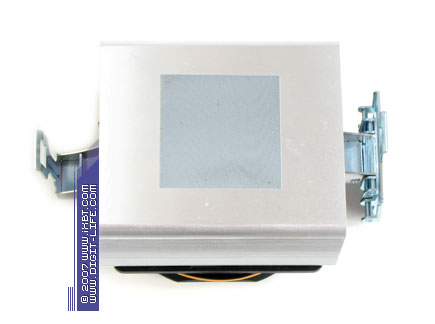 What concerns pure practice, the new Igloo 7222 products keep their line of succession, they preserve and even multiply success of the parent Igloo 7220 family - they demonstrate decent thermal results and ergonomic noise characteristics, achieving a better efficiency/noise ratio. As a result, Igloo 7222 Light (E) and Igloo 7222 (E) shoot forward in their functionality and take up vanward positions in our usability and economic ratings, competing with many other products (not only budget models, but higher-class coolers as well). GlacialTech Igloo 7320 Silent (E), Igloo 7320 Light (E), Igloo 7320 (E), and Igloo 7320 TC (E)Representatives of another GlacialTech's budget family (7320 Silent (E), Igloo 7320 Light (E), Igloo 7320 (E), and Igloo 7320 TC (E)) also follow the general line drawn by their predecessors. These coolers are based on the same aluminum heat sink (85x85x47 mm, 65x58 at the base), they are equipped with a 80x80x25 mm fan (plain bearing), and they differ in fan speed (2000 rpm, 2600 rpm, and 3200 rpm). The TC-suffixed model is additionally equipped with the rpm control circuit depending on the CPU temperature (rotational speed of the fan varies from 1600 to 3200 rpm within 25-45°C). 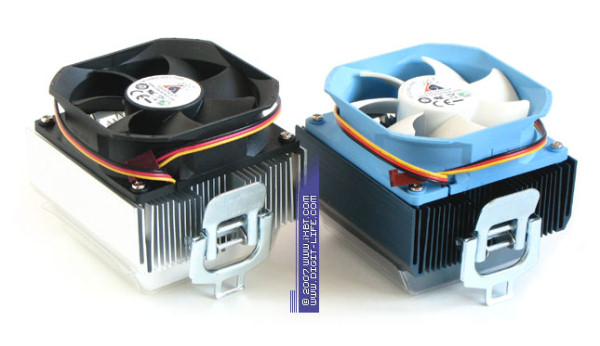 GlacialTech Igloo 7320 Silent (E) and Igloo 7320 TC (E) Igloo 7320 coolers resemble their Igloo 7310 forefathers - they are equipped with heat sinks of almost the same design, similar fans, and very convenient proprietary retention modules. But unlike the Igloo 7222, the changes are qualitative rather than quantitative - a faster fan with better aerodynamic parameters and a heat sink with modified fins optimize thermal and noise characteristics in the first place. Economic weight and dimensions are only a secondary objective. 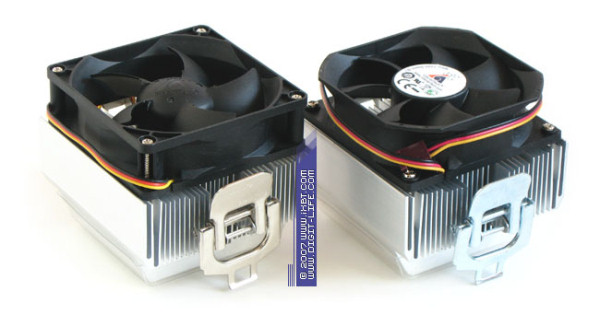 GlacialTech Igloo 7310 Light and Igloo 7320 Silent (E) The improved heat sink becomes the main feature of the Igloo 7320 - along with the traditional catalysts of thermal efficiency (trapezoid fins of alternating height) and high-tech parameters of finning (0.6 mm thick at the base and 0.3 mm at the tip, placed at 2 mm steps, total heat exchange surface of about 1800 cm2), these products demonstrate a well structured center of the working medium (that creates better conditions for heat exchange in this area, where the air flow is not sufficient) and an offloaded peripheral part of finning, which is compensated with the increased performance of the fan. As a result, the updated fan and the improved heat sink form even a more harmonious duet than the parent Igloo 7310 coolers.  The new Igloo 7320 family do not miss a chance to utilize their potential to full extent and demonstrate excellent results: the updated coolers successfully compete with the other contenders, the Igloo 7320 (E) achieves practically impossible results - it's on a par with the Titan TTC-NK32TZ (with heat pipes) in thermal efficiency, demonstrating a better efficiency/noise ratio.  The budget Igloo 7320 coolers show attractive functionality - these four products take vanward positions in our ratings. And the Igloo 7320 Silent (E) wins the title of an absolute champion in this shootout. Thermaltake CL-P0444 and TMG A3Now let's examine two budget coolers from Thermaltake - the CL-P0444 and the TMG A3. 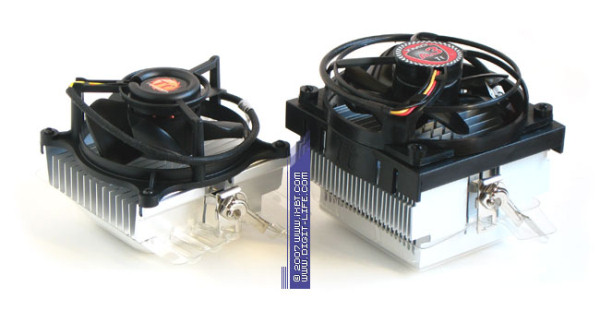 Thermaltake CL-P0444 and TMG A3 The CL-P0444 demonstrates disordered technical properties. We can even say that it's a chuckle product - the imposing "inverted" fan (92x92x38 mm, plain bearing, 2200 rpm fan) is installed on an aluminum heat sink (92x89x35 mm, 72x67 at the base) of a primitive configuration (just fifteen 0.7 mm fins at 5 mm steps), which total heat exchange surface barely reaches 600 cm2.  I don't understand why Thermaltake engineers mated a weak heat sink with a relatively expensive fan - they could have easily made the finning twice as dense in the very least, to design a serious fan-heat sink couple. However the fact remains - the CL-P0444 is too weak as far as its thermal efficiency is concerned, and it will be foolish to expect good results from this cooler.  Practice proves our assumptions - the budget CL-P0444 demonstrates very low thermal efficiency even with its good on-board fan, it's efficiency/noise ratio is not very good. It ruins the image of this cooler, and it takes bottom positions in our usability and economic ratings. The other budget cooler from Thermaltake (TMG A3) is a representative of the new TMG (Thermal Maximum Grade) brand group. So it tries to confirm its high status and produces a much better impression - this cooler is based on a large aluminum heat sink (92x90x53 mm, 77x67 mm at the base), it's equipped with an "inverted" fan (92x92x32 mm, plain bearing, 2000 rpm), and it's spiced up with a proprietary toolless retention module.  The TMG A3 can boast of developed finning with advanced parameters (trapezoid fins, 0.8 mm thick at the base and 0.4 mm at the tip, placed at 2 mm steps, 29 fins with the total heat exchange surface area of about 2100 cm2), spiced up with an additional thermal catalyst - alternating fin height. Pay attention to the on-board fan, or to be more exact, to the way it's mounted on the heat sink: it's not held rigidly, it's mounted with spring stops acting as vibration dampers that silence extraneous sounds in the noise spectrum of this cooler. The TMG A3 offers good performance attributes - despite its large working medium, its outer contour agrees with AMD requirements, so the cooler sits in the socket well, and the proprietary mounting clip inherited from the TR2 R1 makes the installation process nice and easy. The TMG A3 also comes with a preinstalled thermal interface - improved thermal grease based on aluminum oxide.  This product performs very well. Even though the TMG A3 is a tad less efficient in thermal terms than the TR2 R1, it still demonstrates decent thermal results and a respectable efficiency/noise ratio. As a result, it accumulates a lot of attributes that have a positive effect on its usability rating. However, its economic rating is lower - it's price is too high. Titan Data Cooler DC-K8J825Z/N/G and DC-K8H925Z/NThe last coolers to be reviewed here are budget Data Cooler products from Titan - DC-K8J825Z/N/G and DC-K8H925Z/N. 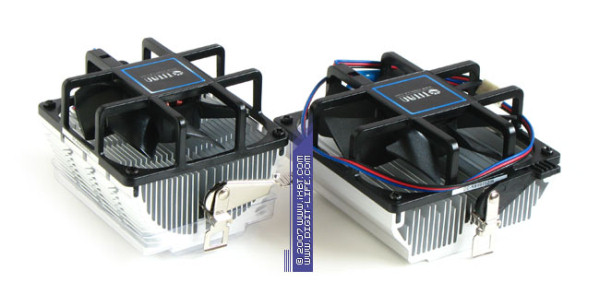 Titan Data Cooler DC-K8J825Z/N/G and DC-K8H925Z/N The DC-K8J825Z/N/G copies the leading idea of Foxconn NBT-CMAM23B-C - it's equipped with an aluminum heat sink (77x77x38 mm, 77x37 mm at the base) of practically the same configuration with a U-shaped carrier. However, the on-board fan is different - an "inverted" fan (plain bearing, 2200 rpm). Besides, fin parameters have been slightly modified as well (trapezoid fans, 0.7 mm at the base and 0.3 mm at the tip, placed at 2 mm steps, the total heat exchange surface of about 800 cm2). 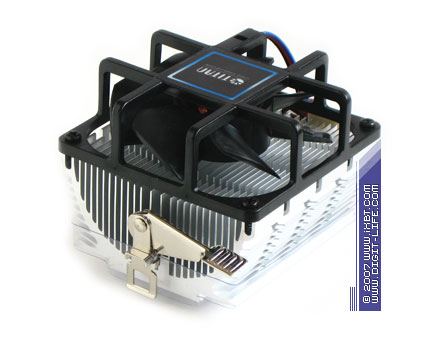 However, the DC-K8J825Z/N/G cannot offer anything new. This product is outperformed by the NBT-CMAM23B-C both in thermal and noise parameters. It shows a worse efficiency/noise ratio (to all appearances, the open impeller of the fan fails to pump air through the dense finning, it does more harm than good).  It has a negative effect on the technical image of the cooler - the DC-K8J825Z/N/G fails to get a good score even with its preinstalled thermal grease and user-friendly retention module. So it slides down to the bottom of our ratings. The other budget cooler from Titan, the DC-K8H925Z/N, looks more optimistic. It's based on the low-profile aluminum heat sink (88x89x32 mm, 77x45 mm at the base), it's equipped with an "inverted" fan (92x92x25 mm, plain bearing, 2200 rpm) and a toolless retention module.  Possessing low-profile dimensions, the DC-K8H925Z/N is not shy of being short and demonstrates a good set of fin parameters (trapezoid fins, 0.7 mm at the base and 0.3 mm at the tip, placed at 2 mm steps, the total heat exchange surface of about 900 cm2), spiced up with an additional catalyst of thermal efficiency - alternating fin height. That is we get a well-ventilated heat sink, where the entire fin surface works efficiently.  Indeed, the DC-K8H925Z/N demonstrates acceptable thermal efficiency and competes well with other budget products. But the situation with noise is not that peachy - this cooler generates a relatively high noise level, crossing the ergonomic mark of 40 dBA. As a result, the DC-K8H925Z/N is outscored even by the weak DC-K8J825Z/N/G. So it inevitably moves to the bottom of our ratings. We have examined all main contenders of our today's shootout. It's time to have a look at the test results! Note: our shootout also includes some more budget coolers, which haven't been examined here. In particular: 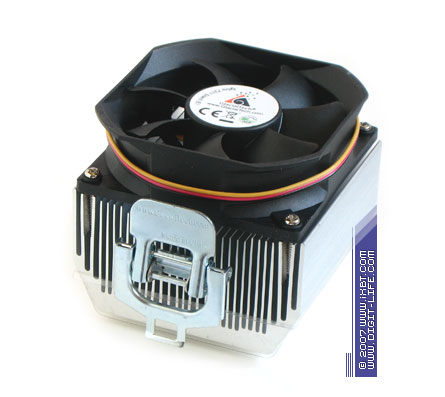 GlacialTech Igloo 7311 Silent (E) is a copy of the Igloo 7320 in many respects, only its heat sink is smaller; 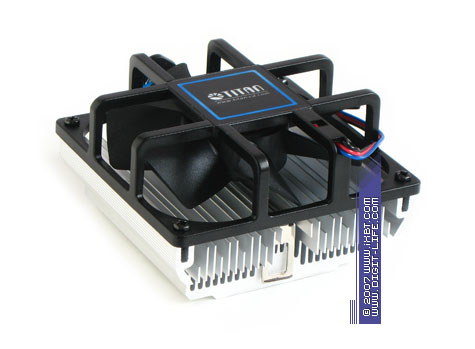 Titan DC-K8K925Z/N/G is technically identical to the DC-K8H925Z/N, it's a re-marked version of this cooler. Vitali Crinitsin (vit@ixbt.com)
November 23, 2007 Write a comment below. No registration needed!
|
Platform · Video · Multimedia · Mobile · Other || About us & Privacy policy · Twitter · Facebook Copyright © Byrds Research & Publishing, Ltd., 1997–2011. All rights reserved. |